HI6028 Taxation Law: Capital Gains, Income, and Loan Assessment
VerifiedAdded on 2023/03/23
|9
|2244
|63
Case Study
AI Summary
This assignment presents a detailed case study focused on taxation law, analyzing various financial transactions and their tax implications. It examines the Capital Gains Tax (CGT) implications of selling inherited artwork and collectibles, determining whether these assets are subject to CGT based on acquisition dates and values. The study further investigates the taxability of income earned from writing and selling a book, including copyright assignments and manuscript sales, differentiating between income from personal exertion and potential hobby income. Lastly, it assesses the tax implications of a loan arrangement between family members, specifically whether the additional amount paid upon repayment constitutes taxable income. The analysis incorporates relevant sections of the ITAA1997, case laws, and tax rulings to provide a comprehensive understanding of the tax consequences in each scenario. Desklib offers similar solved assignments and resources for students.
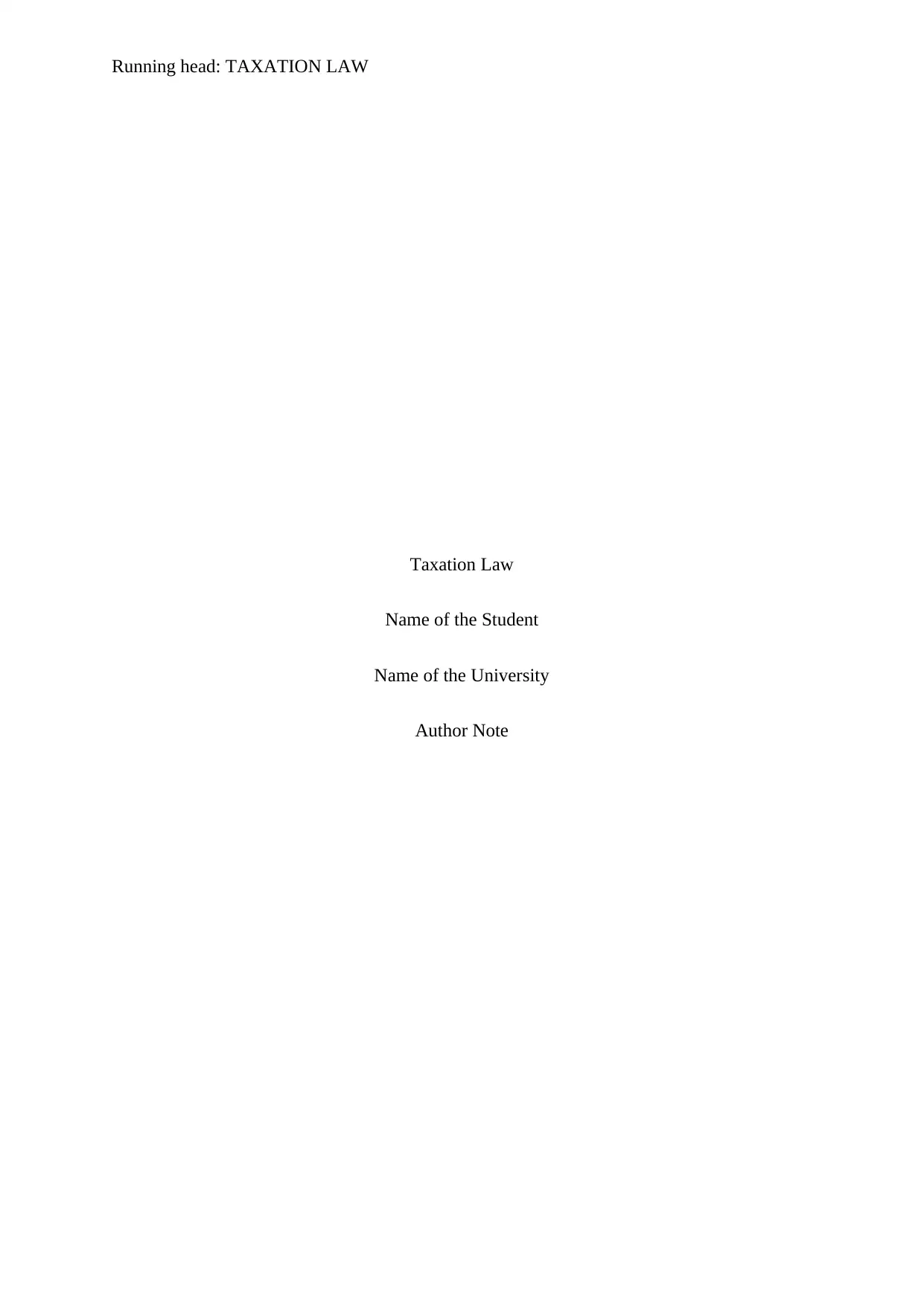
Running head: TAXATION LAW
Taxation Law
Name of the Student
Name of the University
Author Note
Taxation Law
Name of the Student
Name of the University
Author Note
Paraphrase This Document
Need a fresh take? Get an instant paraphrase of this document with our AI Paraphraser

1TAXATION LAW
Answer 1
Transaction 1
An antique impressionism painting purchased by the father of Helen for a price of $4000
in the February of the year 1985 has been sold by Helen for a price of $12000 in the year
2018. U/s 102.20 ITAA1997 states that any loss as well as gain that is said to be a CGT gain
or loss needs to be accompanied by a transaction relating to CGT assets causing a CGT event.
Disposal of CGT asset is required to be treated as A1 category of CGT event u/s 104.10
ITAA1997. However, only those assets that has been purchased or owned by a person in a
date succeeding 20/09/1985 will be treated as a CGT asset and prior to that date no asset
activate will be treated as a CGT asset. In the instant transaction the painting has been bought
by Helen’s father prior to the prescribed date that is required to be complied with for the
purpose of being rendered as a CGT asset. Although it can be stated as a CGT asset and can
be categorised in A1 category of CGT events but the same cannot be treated assessable under
the CGT for the purpose of being acquired prior to the prescribed date. Hence this transaction
will be disregarded for the purpose of CGT computation.
Transaction 2
A historical sculpture husband sold by Helen photo price of $6,000, which has been
required for $5,500 on December 1993. The definition of the word collectible is given u/s
108-10(2) ITAA1997. It includes any item that is held by a person for the purpose of personal
enjoyment. This covers any artwork, jewellery, antique object or certain other similar items.
Again collectible is only II taxable under the CGT if the same has a price exceeding $500 as
per s 118.10 ITAA1997. Any collectible that does not exceed prescribed amount will be
construed as an exempt from CGT computation u/s 110-10 ITAA1997. The sculpture has
been acquired in 1993 which is after the prescribed date and hence is regarded as eligible for
Answer 1
Transaction 1
An antique impressionism painting purchased by the father of Helen for a price of $4000
in the February of the year 1985 has been sold by Helen for a price of $12000 in the year
2018. U/s 102.20 ITAA1997 states that any loss as well as gain that is said to be a CGT gain
or loss needs to be accompanied by a transaction relating to CGT assets causing a CGT event.
Disposal of CGT asset is required to be treated as A1 category of CGT event u/s 104.10
ITAA1997. However, only those assets that has been purchased or owned by a person in a
date succeeding 20/09/1985 will be treated as a CGT asset and prior to that date no asset
activate will be treated as a CGT asset. In the instant transaction the painting has been bought
by Helen’s father prior to the prescribed date that is required to be complied with for the
purpose of being rendered as a CGT asset. Although it can be stated as a CGT asset and can
be categorised in A1 category of CGT events but the same cannot be treated assessable under
the CGT for the purpose of being acquired prior to the prescribed date. Hence this transaction
will be disregarded for the purpose of CGT computation.
Transaction 2
A historical sculpture husband sold by Helen photo price of $6,000, which has been
required for $5,500 on December 1993. The definition of the word collectible is given u/s
108-10(2) ITAA1997. It includes any item that is held by a person for the purpose of personal
enjoyment. This covers any artwork, jewellery, antique object or certain other similar items.
Again collectible is only II taxable under the CGT if the same has a price exceeding $500 as
per s 118.10 ITAA1997. Any collectible that does not exceed prescribed amount will be
construed as an exempt from CGT computation u/s 110-10 ITAA1997. The sculpture has
been acquired in 1993 which is after the prescribed date and hence is regarded as eligible for

2TAXATION LAW
being allowed as a collectible, which constitutes of CGT asset. Again the price of the same
has exceeded the prescribed limit for the purpose of making a collectible taxable. To be more
precise the price for which the sculpture has been acquired is $5,500. Hence, it can be said
that by applying s 118-10 ITAA1997 it can be treated as a CGT asset and consequently will
be allowed as a component of CGT computation.
Transaction 3
Another sale made by Helen involves the antique jewellery that she acquired in the year
1987 for a price of $14000 and for a selling price of $13,000. U/s 108-10 ITAA1997, a loss
that is sustained by a taxpayer in a transaction with respect to collectibles is required to be
considered as offset. However the treatment of such a loss as an offset is required to be
affected only against CGT gain that has been accompanied by a collectible transaction only.
The loss sustained by the taxpayer with respect to a collectible cannot be treated as an offset
against any other CGT asset other than collectible gain. In this transaction jewellery is
required to be treated as a collectible. It is taxable as it has been acquired after the prescribed
a date of CGT introduction as well as the same has exceeded threshold of $500. Being a
collectible and making the taxpayer sustaining a loss will render the loss to be treated as an
offset against a collectible gain only. In the present situation the only collectible transaction is
the transaction with respect to the historical sculpture and hence the loss accruing from the
sale of the Jewellery will required to be treated as an asset while computing the CGT of the
historical sculpture.
Transaction 4
A picture that has been acquired in the year 1987 for a price of $470 has been sold by
Helen for a price of $5000 in the year 2018. CGT asset that are used for the purpose of
personal use is required to be subjected to CGT u/s 108-20 ITAA1997. Any such asset, if
exceeds the price of $10000 will be regarded as a CGT asset and will be subjected to CGT
being allowed as a collectible, which constitutes of CGT asset. Again the price of the same
has exceeded the prescribed limit for the purpose of making a collectible taxable. To be more
precise the price for which the sculpture has been acquired is $5,500. Hence, it can be said
that by applying s 118-10 ITAA1997 it can be treated as a CGT asset and consequently will
be allowed as a component of CGT computation.
Transaction 3
Another sale made by Helen involves the antique jewellery that she acquired in the year
1987 for a price of $14000 and for a selling price of $13,000. U/s 108-10 ITAA1997, a loss
that is sustained by a taxpayer in a transaction with respect to collectibles is required to be
considered as offset. However the treatment of such a loss as an offset is required to be
affected only against CGT gain that has been accompanied by a collectible transaction only.
The loss sustained by the taxpayer with respect to a collectible cannot be treated as an offset
against any other CGT asset other than collectible gain. In this transaction jewellery is
required to be treated as a collectible. It is taxable as it has been acquired after the prescribed
a date of CGT introduction as well as the same has exceeded threshold of $500. Being a
collectible and making the taxpayer sustaining a loss will render the loss to be treated as an
offset against a collectible gain only. In the present situation the only collectible transaction is
the transaction with respect to the historical sculpture and hence the loss accruing from the
sale of the Jewellery will required to be treated as an asset while computing the CGT of the
historical sculpture.
Transaction 4
A picture that has been acquired in the year 1987 for a price of $470 has been sold by
Helen for a price of $5000 in the year 2018. CGT asset that are used for the purpose of
personal use is required to be subjected to CGT u/s 108-20 ITAA1997. Any such asset, if
exceeds the price of $10000 will be regarded as a CGT asset and will be subjected to CGT
⊘ This is a preview!⊘
Do you want full access?
Subscribe today to unlock all pages.

Trusted by 1+ million students worldwide
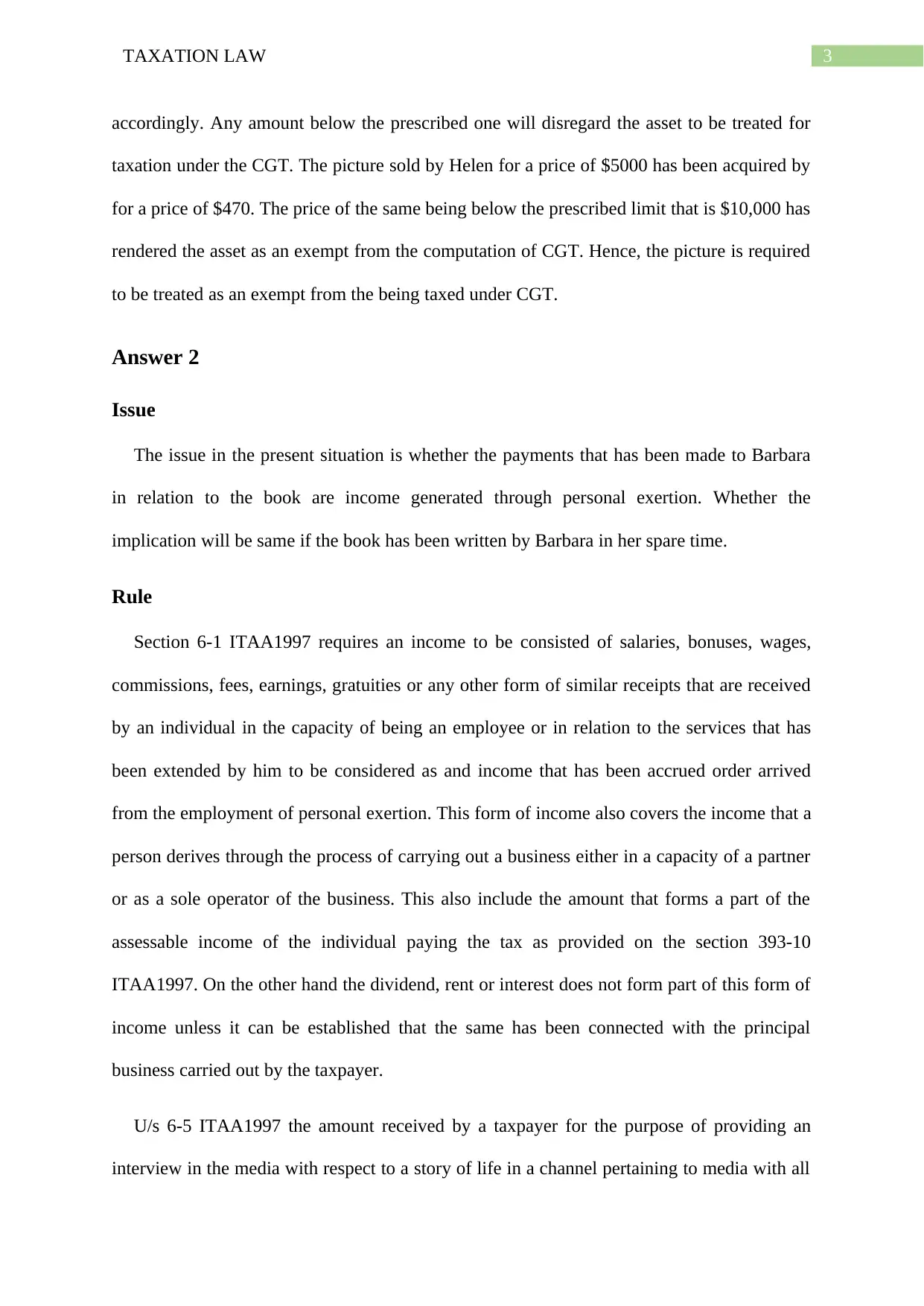
3TAXATION LAW
accordingly. Any amount below the prescribed one will disregard the asset to be treated for
taxation under the CGT. The picture sold by Helen for a price of $5000 has been acquired by
for a price of $470. The price of the same being below the prescribed limit that is $10,000 has
rendered the asset as an exempt from the computation of CGT. Hence, the picture is required
to be treated as an exempt from the being taxed under CGT.
Answer 2
Issue
The issue in the present situation is whether the payments that has been made to Barbara
in relation to the book are income generated through personal exertion. Whether the
implication will be same if the book has been written by Barbara in her spare time.
Rule
Section 6-1 ITAA1997 requires an income to be consisted of salaries, bonuses, wages,
commissions, fees, earnings, gratuities or any other form of similar receipts that are received
by an individual in the capacity of being an employee or in relation to the services that has
been extended by him to be considered as and income that has been accrued order arrived
from the employment of personal exertion. This form of income also covers the income that a
person derives through the process of carrying out a business either in a capacity of a partner
or as a sole operator of the business. This also include the amount that forms a part of the
assessable income of the individual paying the tax as provided on the section 393-10
ITAA1997. On the other hand the dividend, rent or interest does not form part of this form of
income unless it can be established that the same has been connected with the principal
business carried out by the taxpayer.
U/s 6-5 ITAA1997 the amount received by a taxpayer for the purpose of providing an
interview in the media with respect to a story of life in a channel pertaining to media with all
accordingly. Any amount below the prescribed one will disregard the asset to be treated for
taxation under the CGT. The picture sold by Helen for a price of $5000 has been acquired by
for a price of $470. The price of the same being below the prescribed limit that is $10,000 has
rendered the asset as an exempt from the computation of CGT. Hence, the picture is required
to be treated as an exempt from the being taxed under CGT.
Answer 2
Issue
The issue in the present situation is whether the payments that has been made to Barbara
in relation to the book are income generated through personal exertion. Whether the
implication will be same if the book has been written by Barbara in her spare time.
Rule
Section 6-1 ITAA1997 requires an income to be consisted of salaries, bonuses, wages,
commissions, fees, earnings, gratuities or any other form of similar receipts that are received
by an individual in the capacity of being an employee or in relation to the services that has
been extended by him to be considered as and income that has been accrued order arrived
from the employment of personal exertion. This form of income also covers the income that a
person derives through the process of carrying out a business either in a capacity of a partner
or as a sole operator of the business. This also include the amount that forms a part of the
assessable income of the individual paying the tax as provided on the section 393-10
ITAA1997. On the other hand the dividend, rent or interest does not form part of this form of
income unless it can be established that the same has been connected with the principal
business carried out by the taxpayer.
U/s 6-5 ITAA1997 the amount received by a taxpayer for the purpose of providing an
interview in the media with respect to a story of life in a channel pertaining to media with all
Paraphrase This Document
Need a fresh take? Get an instant paraphrase of this document with our AI Paraphraser

4TAXATION LAW
the rights inclusive is required to be treated as an income that is assessable in the hands of the
taxpayer.
It has been held in the case of Brent v Federal Commissioner of Taxation (1971) ATC
4195 that any income that a person receives by virtue of telling the story of the life of a
person newsfeed and which is intended to be published in that newspaper particularly is
required to be treated as an assessable income.
It has been held in the case of Housden (Inspector of Taxes) v Marshall (1958), any
amount received by a person for providing any picture or other materials in relation to a
personal experience today newspaper is required to be treated as an income derived from
personal exertion.
Under Tax Ruling 97/11 held that any activity that has been carried out without the
intention of making profit when accrues an income will not be regarded as a taxable income
in the hands of the taxpayer.
Application
In the present scenario it can be stated that the income that has been received by Barbara
has several components and needs to be treated accordingly. The first income that she
receives by writing the book for a price of $13000 dollars is required to be treated as an
income from personal exertion. Again the income that she has earned from the assigning of
the books copyright for an amount of $13400 is required to be treated as capital gain as
copyright is required to be treated as a Capital asset. Again the selling of the manuscripts
book to a book library for a price of $4350 is required to be treated as an income from
personal exertion. Income from the sale of interview manuscripts for a price of $3200 is also
be taxable as an income from personal.
the rights inclusive is required to be treated as an income that is assessable in the hands of the
taxpayer.
It has been held in the case of Brent v Federal Commissioner of Taxation (1971) ATC
4195 that any income that a person receives by virtue of telling the story of the life of a
person newsfeed and which is intended to be published in that newspaper particularly is
required to be treated as an assessable income.
It has been held in the case of Housden (Inspector of Taxes) v Marshall (1958), any
amount received by a person for providing any picture or other materials in relation to a
personal experience today newspaper is required to be treated as an income derived from
personal exertion.
Under Tax Ruling 97/11 held that any activity that has been carried out without the
intention of making profit when accrues an income will not be regarded as a taxable income
in the hands of the taxpayer.
Application
In the present scenario it can be stated that the income that has been received by Barbara
has several components and needs to be treated accordingly. The first income that she
receives by writing the book for a price of $13000 dollars is required to be treated as an
income from personal exertion. Again the income that she has earned from the assigning of
the books copyright for an amount of $13400 is required to be treated as capital gain as
copyright is required to be treated as a Capital asset. Again the selling of the manuscripts
book to a book library for a price of $4350 is required to be treated as an income from
personal exertion. Income from the sale of interview manuscripts for a price of $3200 is also
be taxable as an income from personal.

5TAXATION LAW
However, if the book has been written by Barbara in her spare time and has later on
decided to make the sale of the same, the income from the same is required to be treated as an
income from hobby as per Tax Ruling 97/11 and the same will not be taxable as income from
personal exertion in the hands of Barbara.
Conclusion
The tax implication will be the same as discussed above.
Answer 3
Issue
Whether the arrangement between Patrick and David relating to the loan has any tax
implication open the income of Patrick.
Rule
It has been held in the case of Millard v. FCT 108 CLR 336, any amount a person receives
in any income year must be analysed with respect to the requirements of income to be
allowed in the taxable income in the hands of the taxpayer. The basic requirement in this
regard is the nature of the receipt. This implies that the amount received is required to be
beneficial to the individual in favour of whom the receipt has been accrued and under whose
tax liability it needs to be included.
Again, in the case of Hochstrasser v Mayes [1960] AC 376, court contended that any
amount that an individual receives need to be in the nature of a gain for the purpose of being
included in the tax liability of that person. This needs to be assessed with respect to the
change in position of the individual paying the tax. The individual paying the tax needs to
have been favoured by the amount he has received and needs to be placed in a beneficial
However, if the book has been written by Barbara in her spare time and has later on
decided to make the sale of the same, the income from the same is required to be treated as an
income from hobby as per Tax Ruling 97/11 and the same will not be taxable as income from
personal exertion in the hands of Barbara.
Conclusion
The tax implication will be the same as discussed above.
Answer 3
Issue
Whether the arrangement between Patrick and David relating to the loan has any tax
implication open the income of Patrick.
Rule
It has been held in the case of Millard v. FCT 108 CLR 336, any amount a person receives
in any income year must be analysed with respect to the requirements of income to be
allowed in the taxable income in the hands of the taxpayer. The basic requirement in this
regard is the nature of the receipt. This implies that the amount received is required to be
beneficial to the individual in favour of whom the receipt has been accrued and under whose
tax liability it needs to be included.
Again, in the case of Hochstrasser v Mayes [1960] AC 376, court contended that any
amount that an individual receives need to be in the nature of a gain for the purpose of being
included in the tax liability of that person. This needs to be assessed with respect to the
change in position of the individual paying the tax. The individual paying the tax needs to
have been favoured by the amount he has received and needs to be placed in a beneficial
⊘ This is a preview!⊘
Do you want full access?
Subscribe today to unlock all pages.

Trusted by 1+ million students worldwide
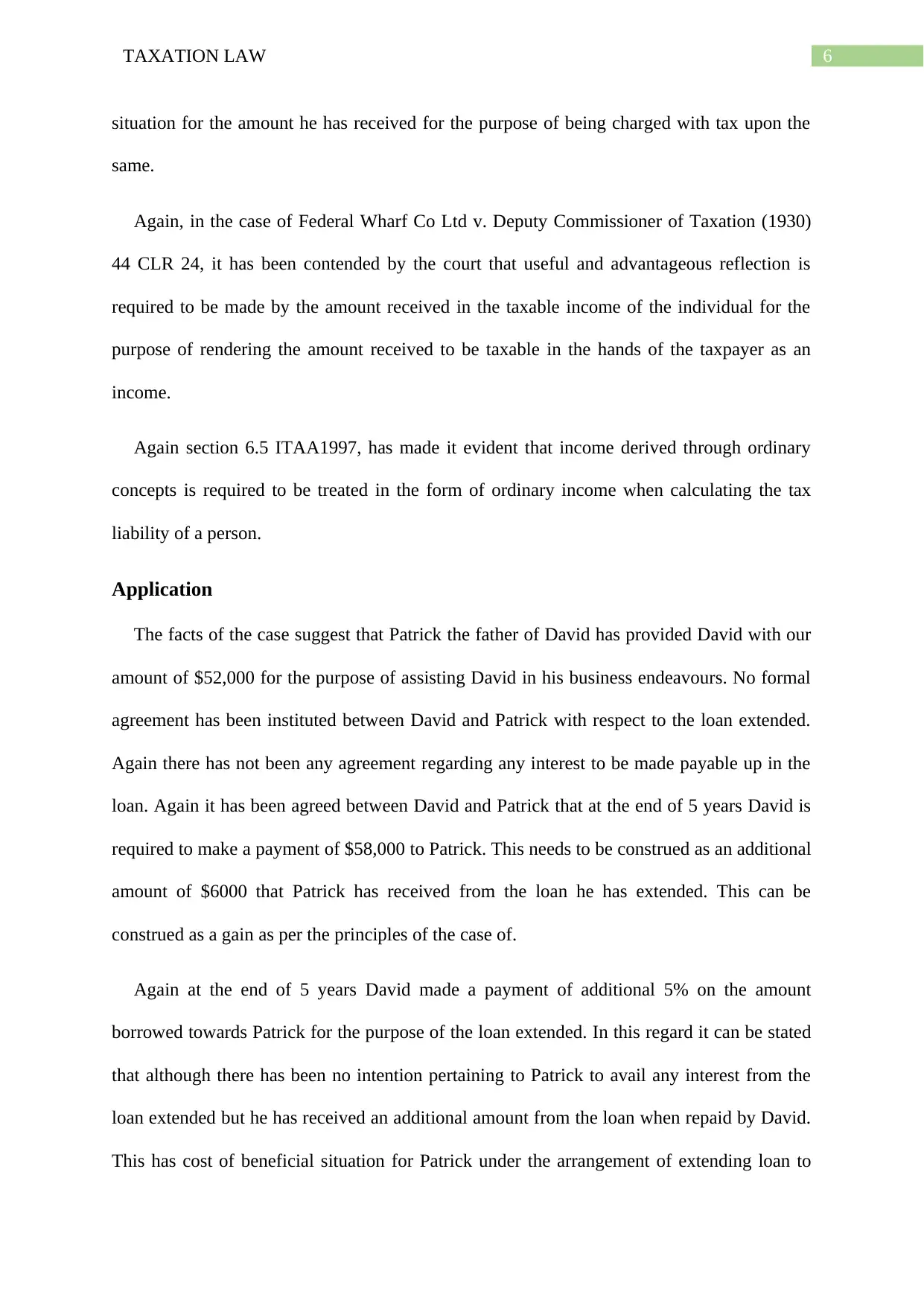
6TAXATION LAW
situation for the amount he has received for the purpose of being charged with tax upon the
same.
Again, in the case of Federal Wharf Co Ltd v. Deputy Commissioner of Taxation (1930)
44 CLR 24, it has been contended by the court that useful and advantageous reflection is
required to be made by the amount received in the taxable income of the individual for the
purpose of rendering the amount received to be taxable in the hands of the taxpayer as an
income.
Again section 6.5 ITAA1997, has made it evident that income derived through ordinary
concepts is required to be treated in the form of ordinary income when calculating the tax
liability of a person.
Application
The facts of the case suggest that Patrick the father of David has provided David with our
amount of $52,000 for the purpose of assisting David in his business endeavours. No formal
agreement has been instituted between David and Patrick with respect to the loan extended.
Again there has not been any agreement regarding any interest to be made payable up in the
loan. Again it has been agreed between David and Patrick that at the end of 5 years David is
required to make a payment of $58,000 to Patrick. This needs to be construed as an additional
amount of $6000 that Patrick has received from the loan he has extended. This can be
construed as a gain as per the principles of the case of.
Again at the end of 5 years David made a payment of additional 5% on the amount
borrowed towards Patrick for the purpose of the loan extended. In this regard it can be stated
that although there has been no intention pertaining to Patrick to avail any interest from the
loan extended but he has received an additional amount from the loan when repaid by David.
This has cost of beneficial situation for Patrick under the arrangement of extending loan to
situation for the amount he has received for the purpose of being charged with tax upon the
same.
Again, in the case of Federal Wharf Co Ltd v. Deputy Commissioner of Taxation (1930)
44 CLR 24, it has been contended by the court that useful and advantageous reflection is
required to be made by the amount received in the taxable income of the individual for the
purpose of rendering the amount received to be taxable in the hands of the taxpayer as an
income.
Again section 6.5 ITAA1997, has made it evident that income derived through ordinary
concepts is required to be treated in the form of ordinary income when calculating the tax
liability of a person.
Application
The facts of the case suggest that Patrick the father of David has provided David with our
amount of $52,000 for the purpose of assisting David in his business endeavours. No formal
agreement has been instituted between David and Patrick with respect to the loan extended.
Again there has not been any agreement regarding any interest to be made payable up in the
loan. Again it has been agreed between David and Patrick that at the end of 5 years David is
required to make a payment of $58,000 to Patrick. This needs to be construed as an additional
amount of $6000 that Patrick has received from the loan he has extended. This can be
construed as a gain as per the principles of the case of.
Again at the end of 5 years David made a payment of additional 5% on the amount
borrowed towards Patrick for the purpose of the loan extended. In this regard it can be stated
that although there has been no intention pertaining to Patrick to avail any interest from the
loan extended but he has received an additional amount from the loan when repaid by David.
This has cost of beneficial situation for Patrick under the arrangement of extending loan to
Paraphrase This Document
Need a fresh take? Get an instant paraphrase of this document with our AI Paraphraser
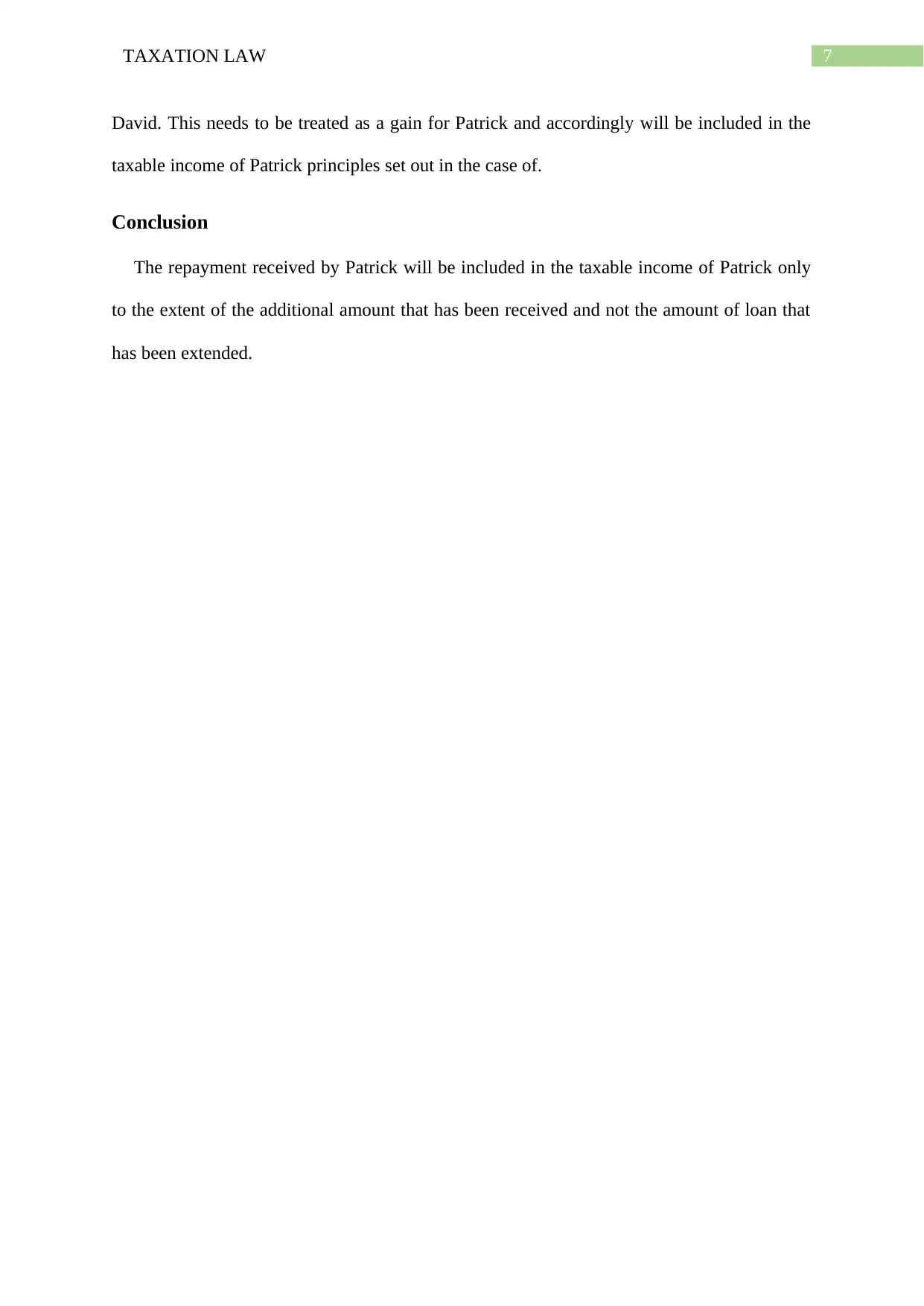
7TAXATION LAW
David. This needs to be treated as a gain for Patrick and accordingly will be included in the
taxable income of Patrick principles set out in the case of.
Conclusion
The repayment received by Patrick will be included in the taxable income of Patrick only
to the extent of the additional amount that has been received and not the amount of loan that
has been extended.
David. This needs to be treated as a gain for Patrick and accordingly will be included in the
taxable income of Patrick principles set out in the case of.
Conclusion
The repayment received by Patrick will be included in the taxable income of Patrick only
to the extent of the additional amount that has been received and not the amount of loan that
has been extended.
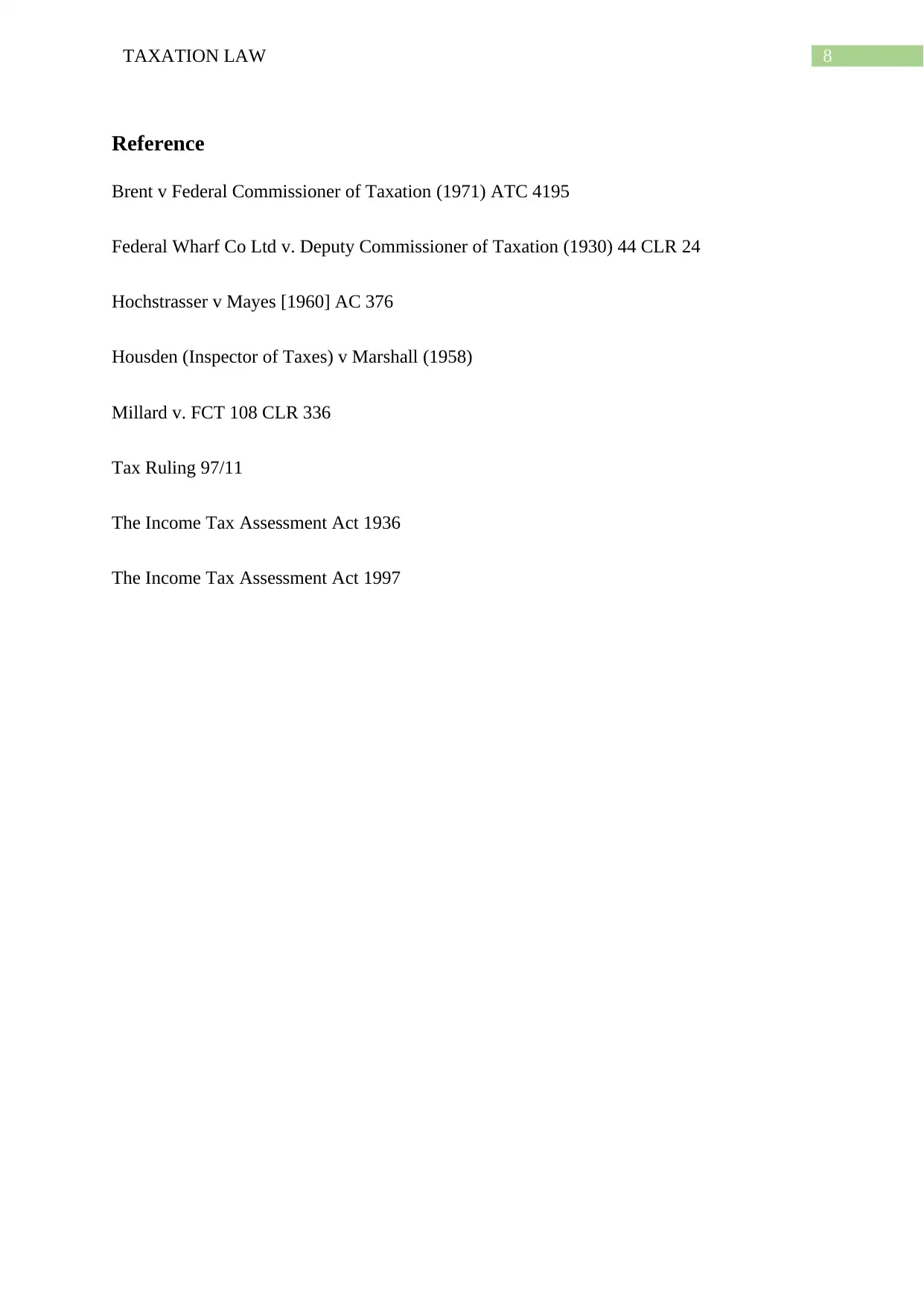
8TAXATION LAW
Reference
Brent v Federal Commissioner of Taxation (1971) ATC 4195
Federal Wharf Co Ltd v. Deputy Commissioner of Taxation (1930) 44 CLR 24
Hochstrasser v Mayes [1960] AC 376
Housden (Inspector of Taxes) v Marshall (1958)
Millard v. FCT 108 CLR 336
Tax Ruling 97/11
The Income Tax Assessment Act 1936
The Income Tax Assessment Act 1997
Reference
Brent v Federal Commissioner of Taxation (1971) ATC 4195
Federal Wharf Co Ltd v. Deputy Commissioner of Taxation (1930) 44 CLR 24
Hochstrasser v Mayes [1960] AC 376
Housden (Inspector of Taxes) v Marshall (1958)
Millard v. FCT 108 CLR 336
Tax Ruling 97/11
The Income Tax Assessment Act 1936
The Income Tax Assessment Act 1997
⊘ This is a preview!⊘
Do you want full access?
Subscribe today to unlock all pages.

Trusted by 1+ million students worldwide
1 out of 9
Related Documents
Your All-in-One AI-Powered Toolkit for Academic Success.
+13062052269
info@desklib.com
Available 24*7 on WhatsApp / Email
![[object Object]](/_next/static/media/star-bottom.7253800d.svg)
Unlock your academic potential
Copyright © 2020–2026 A2Z Services. All Rights Reserved. Developed and managed by ZUCOL.





